Table of Contents
ToggleWhat Is The Pen Tool In Photoshop?
The Pen Tool is a unique feature in Photoshop that creates vector paths rather than editing pixels like the Brush or Pencil Tools. These paths can be seen in the Paths Panel as either Work Paths or Shape Paths, making it a go-to tool for creating smooth-edged selections or custom shapes.Unlike selection tools, the Pen Tool offers precision and flexibility, allowing you to save, modify, and reuse paths as needed.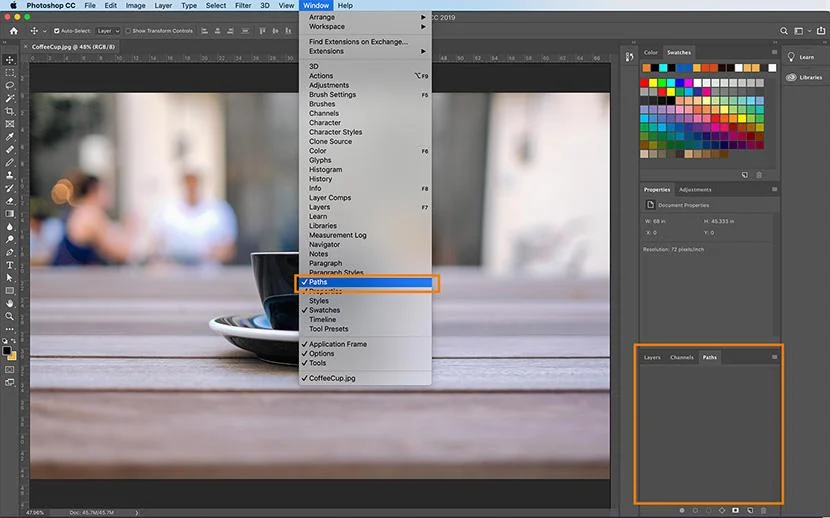
Where to Find the Pen Tool in Photoshop
You can locate the Pen Tool in the Toolbar (lower half by default). Press P on your keyboard to access it quickly. If you click and hold the Pen Tool icon, you’ll see up to six Pen Tool options in Photoshop CC 2018 and later versions (five for older versions):- Standard Pen Tool
- Curvature Pen Tool
- Freeform Pen Tool
- Magnetic Pen Tool (accessible through Freeform Pen Tool settings)
- Add Anchor Point Tool
- Delete Anchor Point Tool
- Convert Point Tool
Where Is the Paths Panel in Photoshop?
The Paths Panel works closely with the Pen Tool. You can access it in the Layers Panel by clicking the Paths tab or by navigating to Window > Paths from the menu bar.
Pen Tool Settings Overview
The Pen Tool offers two primary modes:- Path – Creates a Work Path that appears in the Paths Panel.
- Shape – Creates a Shape Path visible in both the Paths and Layers Panels.
How To Use The Pen Tool In Photoshop To Create A Path
The standard Pen tool enables you to create straight and curved paths with incredible precision, but it takes some practice to master them. Don’t be discouraged as it will feel hard in the beginning. After you create it, you can always adjust a path.
To create a path you can use as a selection, select the standard Pen Tool and then select Path from the drop-down menu in the options bar at the top of the application window.01. Creating A New Path with the Pen Tool
Basically, graphic designers use Photoshop pen tools for making the clipping path. To start your path, click your picture with the mouse to start your path. To keep things simple, select a point of departure at the edge of a straight line, such as the edge of the coffee cup in the picture.
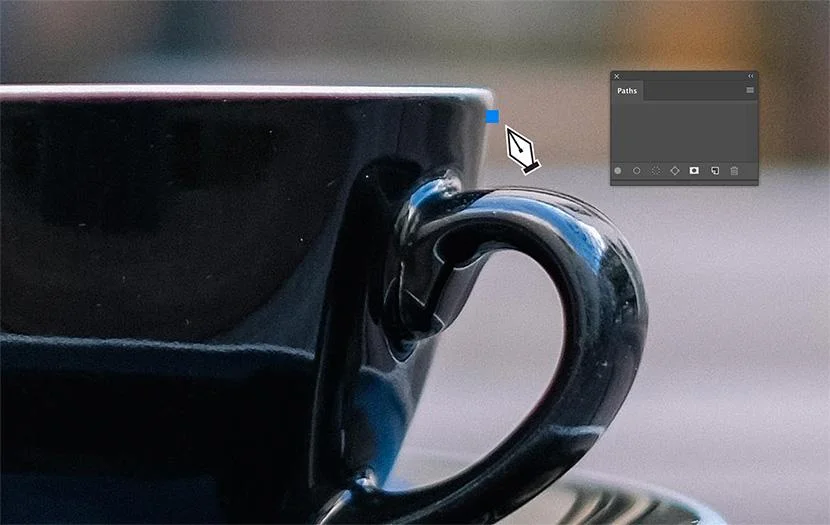
Click again to draw the first segment of your path along the edge of your object using the pen tool. You should see a straight line now. Also, note that a work path appears in the path panel as soon as the second point is placed.
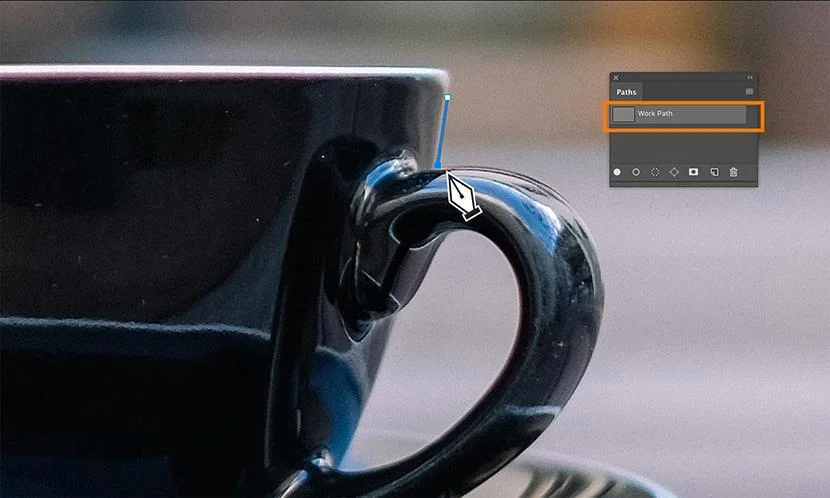
02. Creating A Curved Path Segment with the Pen Tool
Click to the next point and drag with the Pen Tool before you release the mouse button to create a curve with the standard Pen Tool (such as the curve at the edge of the coffee cup. You’ll see lines appearing, called handles.
These handles are tangential to the path’s curve. The movement of the mouse adjusts the handles, which adjusts the curvature of the line. Release the mouse button when you are satisfied with the curve shape.
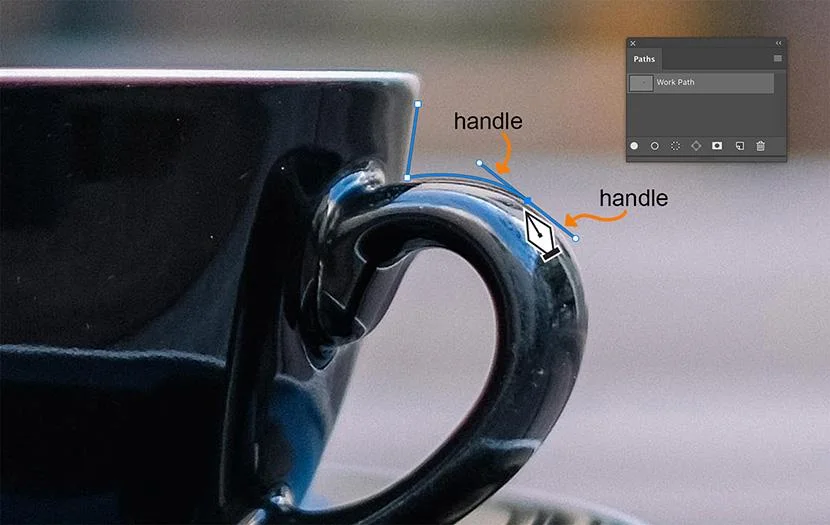
Note that before and after the point, the handles formed from the curved line appear. The next part of the path you draw after you have created a curved line will follow the trajectory of the handle from the last point.
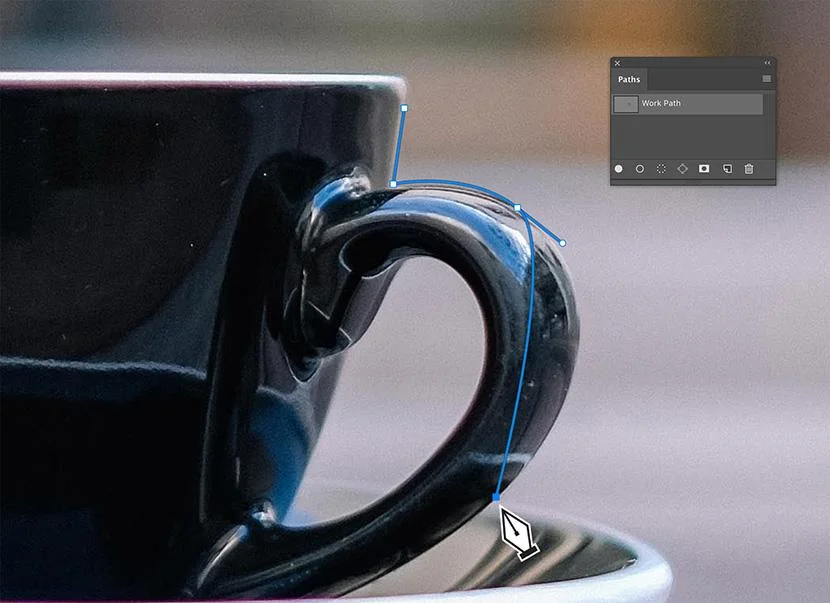 Drag the mouse to create new handles and change the curve that appears with your new point when you click on the next point.
Drag the mouse to create new handles and change the curve that appears with your new point when you click on the next point.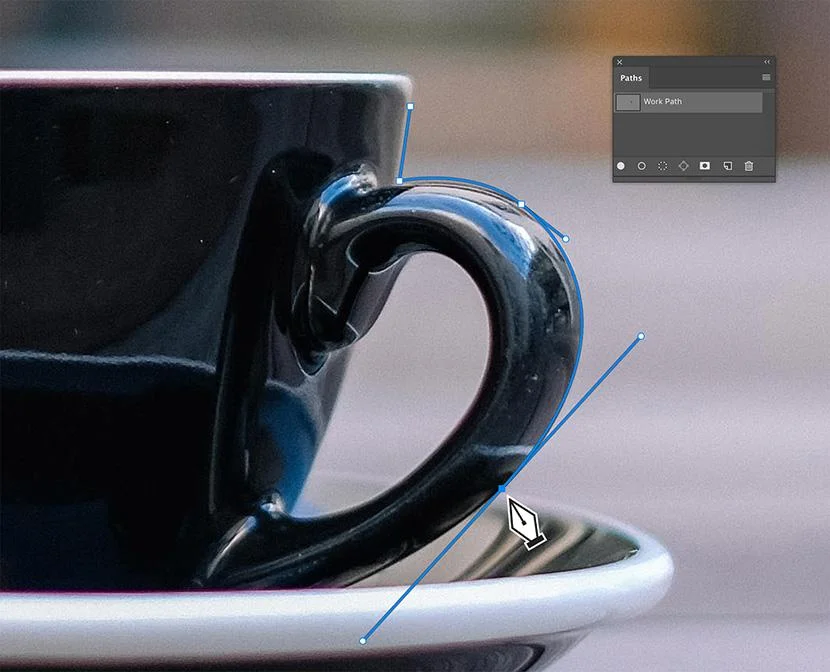
03. Creating A Straight Path Segment
You can “corner” the point by clicking on the point with the mouse while typing ALT if you want to prevent the next segment of your path from curving along with the handle of your last point. The second handle will vanish.
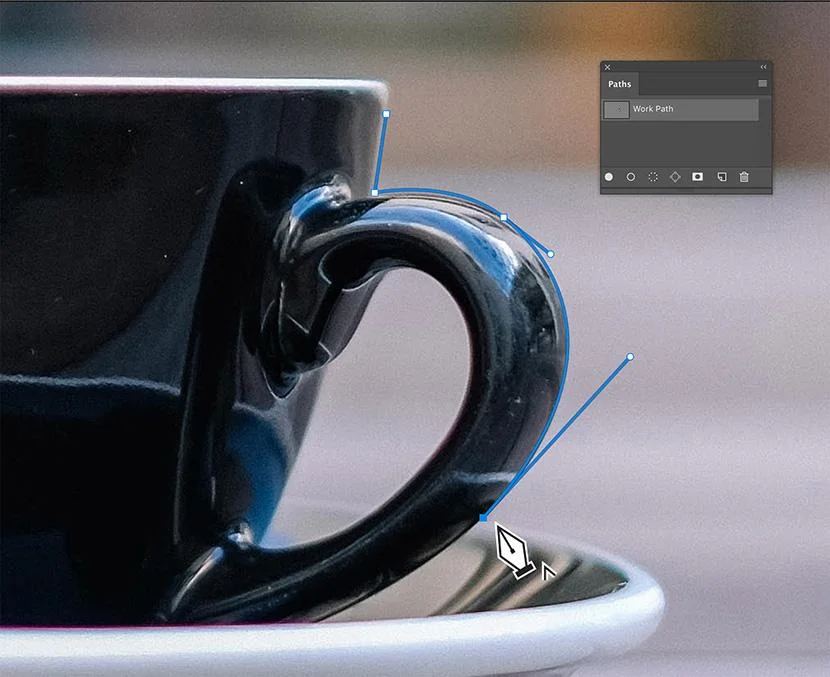 The next point you set won’t be affected by the curve.
The next point you set won’t be affected by the curve.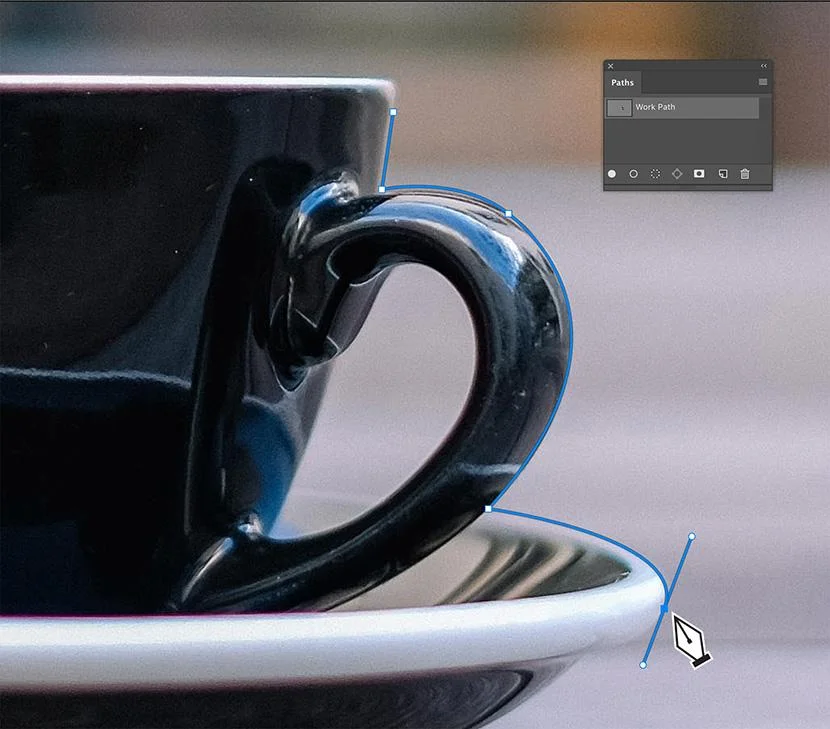
04. Closing Your Path with The Pen Tool
When your path is complete, close your path by switching over the first point you have set. Click on the point when you see a small circle appearing on the right side of the pen tool. Your path will now be closed.
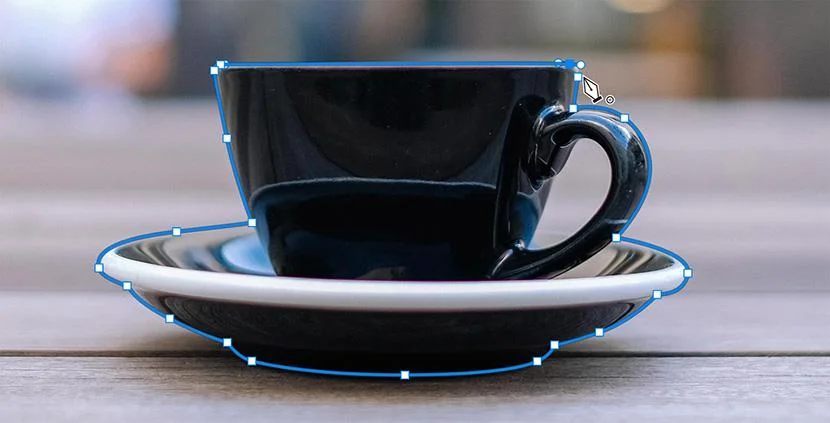
05. How To Save Your Path
Saving your path is super important here. Without saving, you could accidentally overwrite your hard work when you create another path. To save your path, go to the panel of paths and find a new working path. Double-click Work Path to name and save your path.
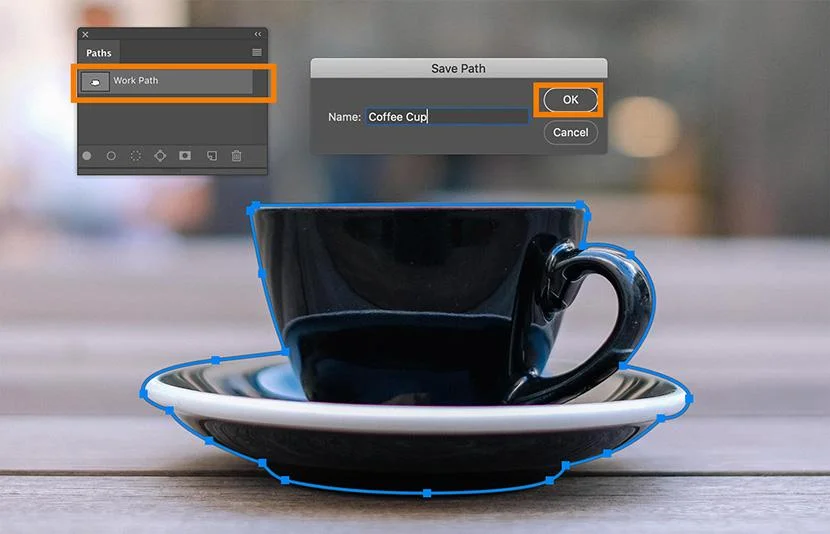
How To Modify an Existing Path with the Pen Tool
After you have created your path, you can change any areas that need to be tweeted. It is useful to zoom in on different areas of your path. If you don’t see your path in your image, click on the path’s name in the Paths Panel. The path will appear in your image, and you’ll be able to adjust it as necessary.
01. How To Add Additional Paths to an Existing Path
In our example of a coffee cup, there is a way out of the cup. However, in order to isolate the cup from the background, we must also create a path around the inside of the handle.
Select the Pen Tool from the Toolbar with the path selected in the Paths panel. Click on the icon that looks like two small overlapping squares in the options bar at the top of the screen and select Exclude overlapping shapes.
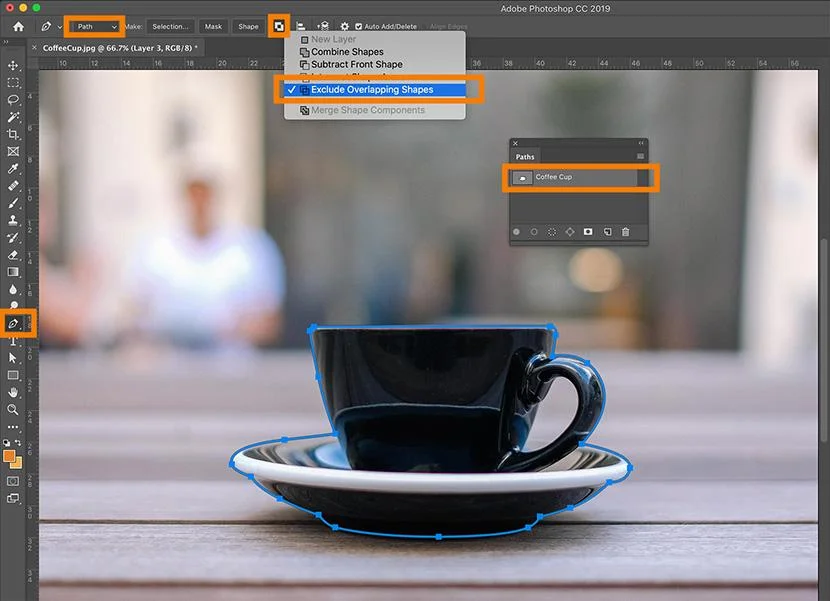
While the current path is still visible, start drawing the area you want to exclude with the pen tool from your selection. When you’re done, close the path.
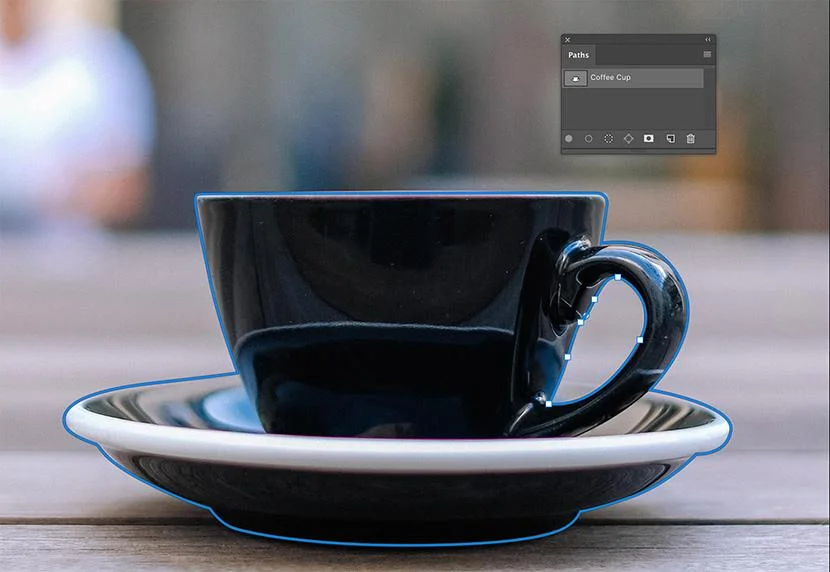 When we make a selection from our path later, the area created with this new path will be cut out from the rest of the selection.
When we make a selection from our path later, the area created with this new path will be cut out from the rest of the selection.02. How To Modify Existing Points and Curves Along a Path
You can find the path selection tools in the toolbar to change an existing point or handle on a path. These tools each look like an arrow and are located in the toolbar under the Type Tool. You will see options when you click on the visible Path Selection tool. Select the tool for direct selection that looks like a white arrow.
With the ‘Direct Selection Tool’, clicking directly on a path segment will reveal all points as white boxes together with the handles of the selected segment. The Direct Selection Tool can be used to drag visible handles to adjust segment curves or to move existing points.
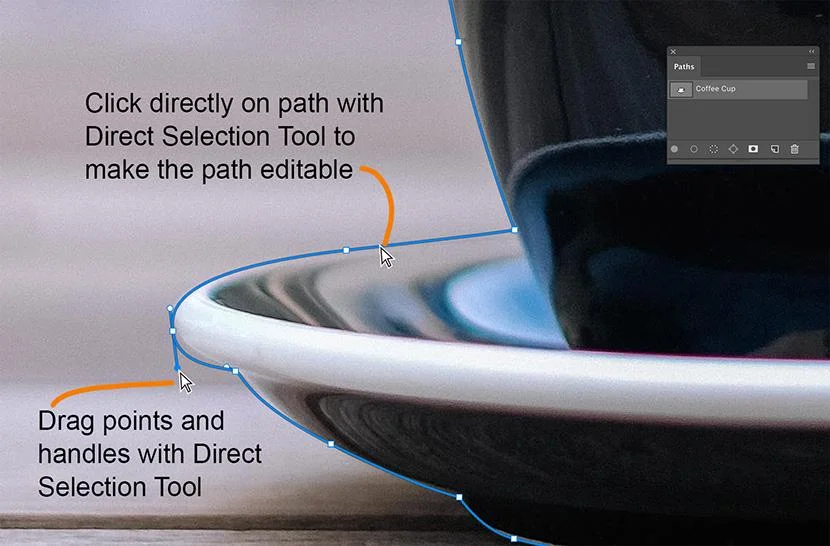
03. How To Add New Points to a Path
The ‘Add Anchor Point Tool’, accessible by clicking and holding on to the Pen Tool in the Toolbar, will add extra points along the path. With the Add Anchor Point Tool selected, hover over the path and click to create a new point. Once you have set the new point, you can change the location of the point or its handles using the Direct Selection tool.
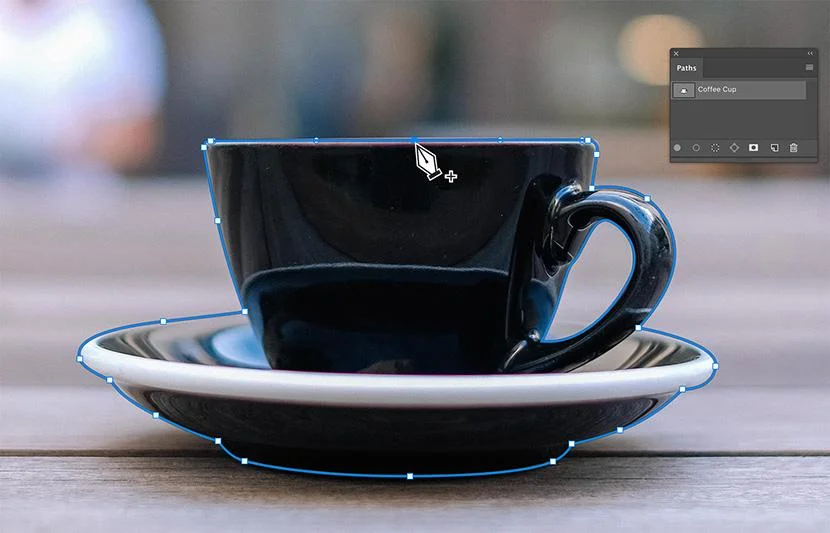
04. How To Remove Points from a Path
The ‘Delete Anchor Point Tool’, also accessible by clicking and holding on to the Pen Tool in the Toolbar, removes existing points from the path. If you select the delete anchor point tool, switch over an existing point until the tool is visible and click. The point is gone, and the surrounding track segments are joined into one segment.
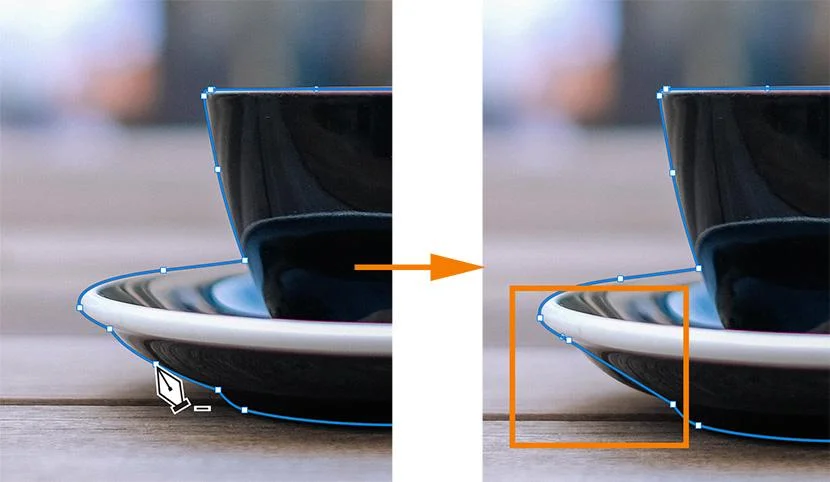
Advanced Techniques with the Pen Tool
01. Convert Point Tool
The ‘Convert Point Tool’, accessed by clicking and holding the Pen Tool, allows you to manipulate exit point handles in the same way that you manipulate handles using the Direct Selection Tool. However, contrary to the Direct Selection Tool, the Convert Point Tool does not allow you to move existing anchor points.
Because the path segments adjacent to the point convert from straight lines to curved lines when you click on a point with the Convert Point Tool and vice versa. When you click on a point with the Convert Point Tool, the handles disappear and the anchor point becomes an angle. If the anchor points around have handles, these handles will still affect the curve of the adjacent track segments.
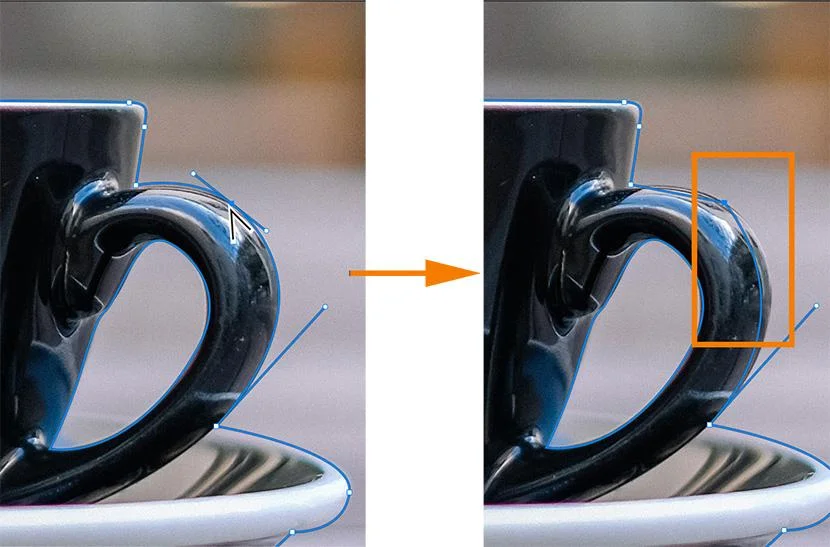 If you use the Convert Point Tool to click on an anchor point that has no handles, the point gains a handle on either side and can be manipulated using the Convert Point Tool or the Direct Selection Tool.
If you use the Convert Point Tool to click on an anchor point that has no handles, the point gains a handle on either side and can be manipulated using the Convert Point Tool or the Direct Selection Tool.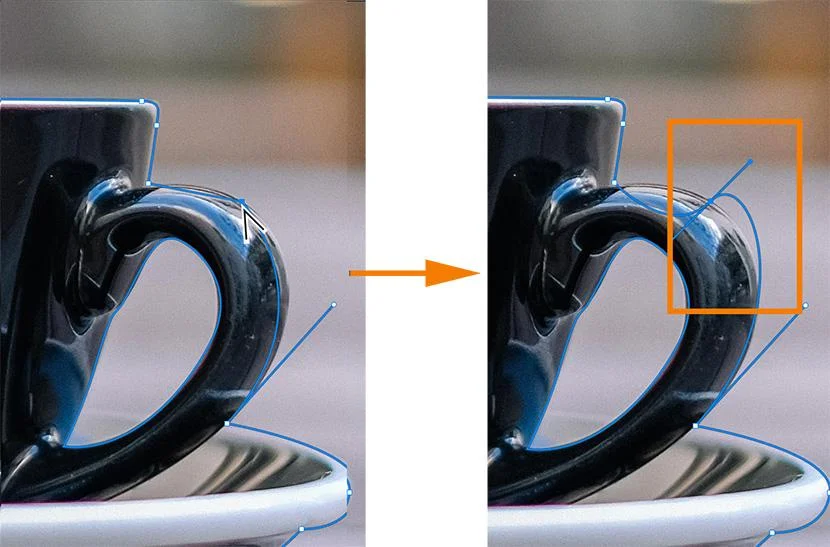
02.Creating a Selection from a Path
Choose your path in your Paths panel. Then click on the icon at the bottom of the panel, which looks like a circle with a diagram. A selection in the form of your path appears on your picture. You can also use the pen tool to create a selection. Click the Select button next to Make: in the Options bar with the selected path and the selected Pen Tool.
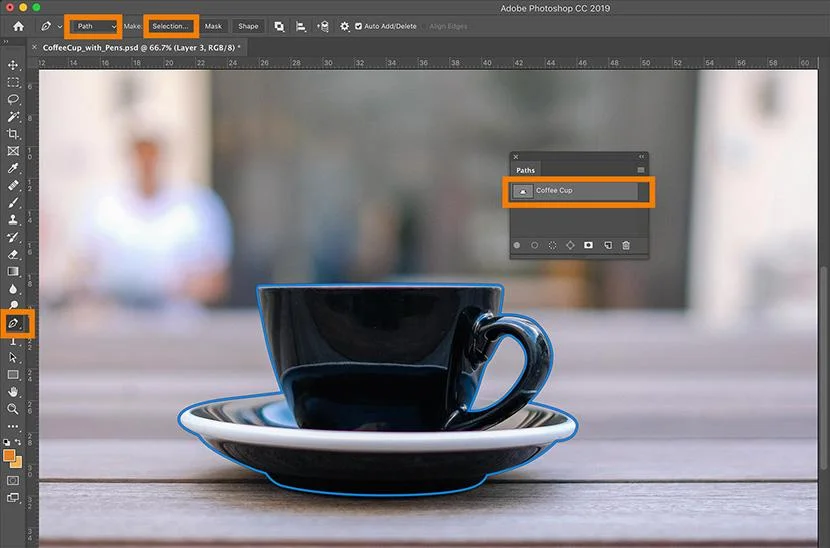
A dialog box will appear that allows you to adjust the selection. If you create a selection to isolate an object from its background, the Feather Radius should be kept at 0 and Anti-Alise checked. If this is the first choice, the radio button next to New Selection will be selected.
Once you have created your selection, you can change the color of the object or remove the object from its background using the selection.

03. Cutting Out an Object from the Background
After you have created your selection from your path, you can either copy it to another layer or create a layer mask to remove the part of the image from its background. You must be in the layer that contains the image you want to isolate to do any of the following methods.
04. Removing A Background By Copying A Selection
You can copy your selection by pressing CTRL+C (COMMAND+C on a Mac) and then paste CTRL+V (COMMAND+V on a Mac) into the selection. Your selection will appear automatically in a new layer. You can make your original layer invisible for viewing the isolated object in the layer panel.
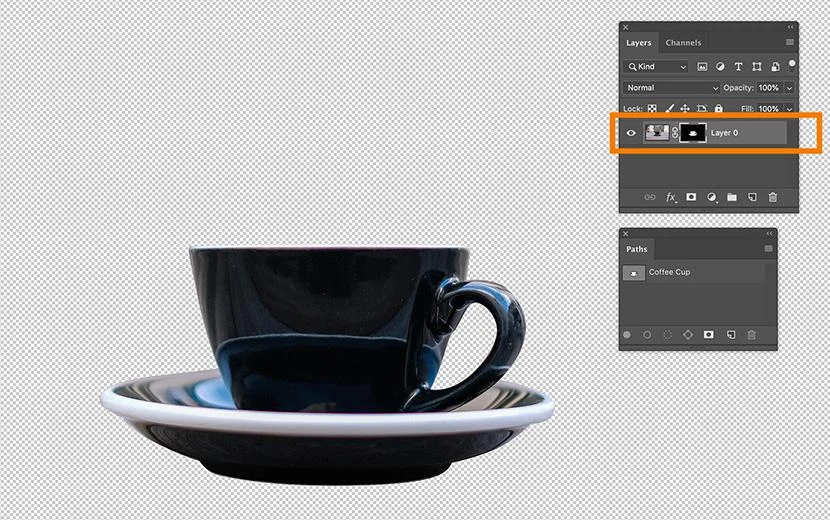
05. Removing A Background by Creating a Layer Mask
To create a layer mask, locate the Layer Mask icon. This icon is available in both the Paths panel and the Layers panel at the bottom of the panel and looks like a white rectangle with a circle inside.
 Click on the icon to automatically create a Layer Mask.
Click on the icon to automatically create a Layer Mask.
06. Creating Shapes with the Pen Tool
You can set a path to a Shape Path before you create the path by choosing Shape from the menu in the Pen Tool options bar. We mentioned this earlier: You can change the color of the shape by double-clicking the color rectangle next to the Fill next to the shape option.
A color menu appears— the color menu top bar allows you to change the color by selecting no fill (transparent), solid color, gradient color, pattern, or custom color. The bottom part of the menu shows the switches available.
Double Click Process
You can also change the color of the shape by double-clicking on the color rectangle next to the punch. To adjust the stroke width, change the width in the drop-down menu to the right of the color of the stroke.
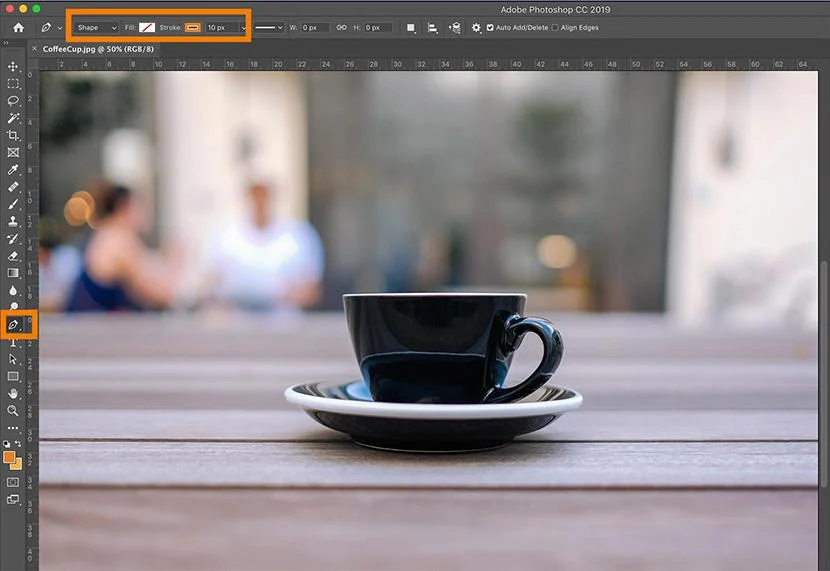
Once you have your Shape Path settings correct, you can draw a shape with the Pen Tool the same way you would draw a regular path.
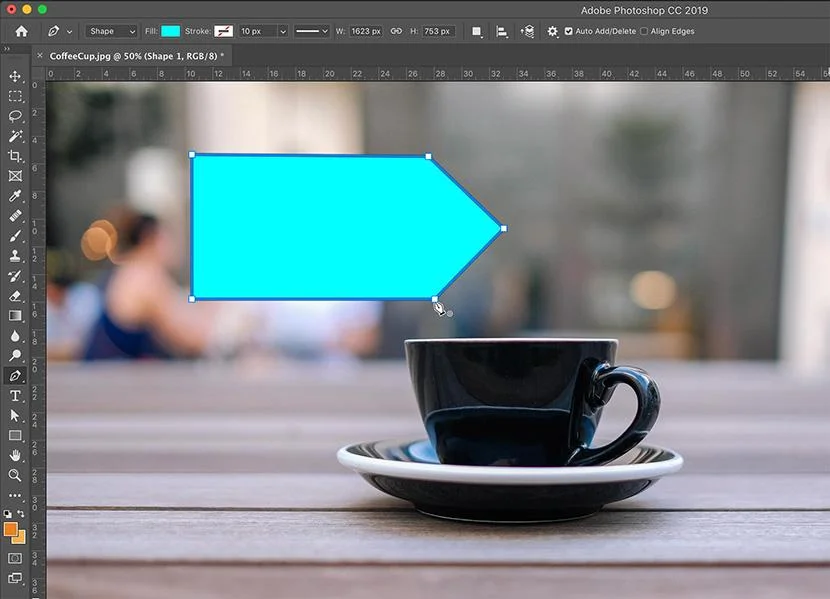
When you create a shape using the Pen Tool, you automatically create a new layer containing that shape, as well as a Shape Path in your Paths panel.
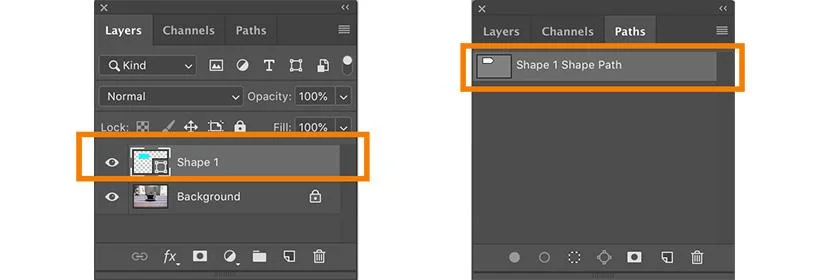
07. Transforming or Scaling a Shape Path
Click the Edit drop-down menu at the top of the screen with the Shape Path selected in your Path panel and select Transform Path to access any of the transform functions. You can also choose Free Transform Path from the Dropdown Edit menu or type Ctrl+T ( Command+T) to scale or rotate your path.
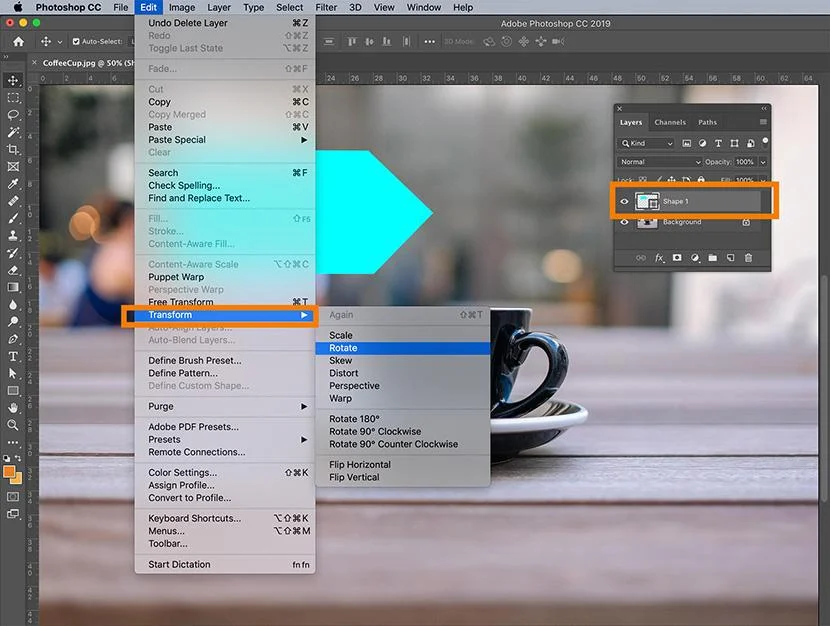
Exploring Other Pen Tool Variations
a. Curvature Pen Tool
This tool simplifies creating curves by estimating the path between points. It’s ideal for uniform shapes like arches or circles.b. Freeform Pen Tool
Draw freely with your mouse or stylus to create a path. While less precise, it’s useful for quick sketches.c. Magnetic Pen Tool
Enable this tool by selecting the Freeform Pen Tool and checking the Magnetic option in the settings. It snaps to edges automatically, making it great for tracing objects.Related Photoshop Tutorials You Might Get Benefited:
Final Thought
Mastering the Photoshop Pen Tool takes practice, but it’s worth the effort for its precision and versatility. Whether you’re creating clipping paths, isolating objects, or designing custom shapes, the Pen Tool is a must-have skill for any graphic designer.Feeling overwhelmed? Let us help! At Clipping World, our team of 150+ designers works 24/7 to handle all your image editing needs. We offer a FREE TRIAL to showcase our quality and provide discounts for large projects.Welcome to today’s blog! At Clipping World, a leading clipping path service provider, we’re diving deep into one of the most powerful tools for graphic designers—the Photoshop Pen Tool.
The pen tool is so versatile and essential that we’ve split this guide into two parts to cover as much as possible. Before we begin, ensure your device has Photoshop CS6 or a later version installed. Let’s explore the magic of the Pen Tool!
What Is The Pen Tool In Photoshop?
The Pen Tool in Photoshop creates vector paths instead of editing pixels, unlike the Brush or Pencil Tools. These paths, visible as Work Paths or Shape Paths in the Paths Panel, are perfect for smooth-edged selections or custom shapes.
Unlike selection tools, the Pen Tool offers precision and flexibility, allowing you to save, modify, and reuse paths as needed.
Where to Find the Pen Tool
The Pen Tool is located in the lower half of the toolbar by default. Press P on your keyboard for quick access. Click and hold the Pen Tool icon to reveal up to six options in Photoshop CC 2018+ (five in older versions):
- Standard Pen Tool
- Curvature Pen Tool
- Freeform Pen Tool
- Magnetic Pen Tool (via Freeform Pen Tool settings)
- Add Anchor Point Tool
- Delete Anchor Point Tool
- Convert Point Tool
Pen Tool Settings Overview
The Pen Tool offers two primary modes:
- Path – Creates a Work Path that appears in the Paths Panel.
- Shape – Creates a Shape Path visible in both the Paths and Layers Panels.
When using the Shape mode, you can customize the stroke color, thickness, and fill color.
Where Is the Paths Panel in Photoshop?
The Paths Panel works closely with the Pen Tool. You can access it in the Layers Panel by clicking the Paths tab or by navigating to Window > Paths from the menu bar.

How To Use The Pen Tool In Photoshop To Create A Path
The standard Pen tool enables you to create straight and curved paths with incredible precision, but it takes some practice to master them. Don’t be discouraged as it will feel hard in the beginning. After you create it, you can always adjust a path.
To create a path you can use as a selection, select the standard Pen Tool and then select Path from the drop-down menu in the options bar at the top of the application window.
01. Creating A New Path with the Pen Tool
Basically, graphic designers use Photoshop pen tools for making the clipping path. To start your path, click your picture with the mouse to start your path. To keep things simple, select a point of departure at the edge of a straight line, such as the edge of the coffee cup in the picture.

Click again to draw the first segment of your path along the edge of your object using the pen tool. You should see a straight line now. Also, note that a work path appears in the path panel as soon as the second point is placed.

02. Creating A Curved Path Segment with the Pen Tool
Click to the next point and drag with the Pen Tool before you release the mouse button to create a curve with the standard Pen Tool (such as the curve at the edge of the coffee cup. You’ll see lines appearing, called handles.
These handles are tangential to the path’s curve. The movement of the mouse adjusts the handles, which adjusts the curvature of the line. Release the mouse button when you are satisfied with the curve shape.

Note that before and after the point, the handles formed from the curved line appear. The next part of the path you draw after you have created a curved line will follow the trajectory of the handle from the last point.

Drag the mouse to create new handles and change the curve that appears with your new point when you click on the next point.

03. Creating A Straight Path Segment
You can “corner” the point by clicking on the point with the mouse while typing ALT if you want to prevent the next segment of your path from curving along with the handle of your last point. The second handle will vanish.

The next point you set won’t be affected by the curve.

04. Closing Your Path with The Pen Tool
When your path is complete, close your path by switching over the first point you have set. Click on the point when you see a small circle appearing on the right side of the pen tool. Your path will now be closed.

05. How To Save Your Path
Saving your path is super important here. Without saving, you could accidentally overwrite your hard work when you create another path. To save your path, go to the panel of paths and find a new working path. Double-click Work Path to name and save your path.

How To Modify an Existing Path with the Pen Tool
After you have created your path, you can change any areas that need to be tweeted. It is useful to zoom in on different areas of your path. If you don’t see your path in your image, click on the path’s name in the Paths Panel. The path will appear in your image, and you’ll be able to adjust it as necessary.
01. How To Add Additional Paths to an Existing Path
In our example of a coffee cup, there is a way out of the cup. However, in order to isolate the cup from the background, we must also create a path around the inside of the handle.
Select the Pen Tool from the Toolbar with the path selected in the Paths panel. Click on the icon that looks like two small overlapping squares in the options bar at the top of the screen and select Exclude overlapping shapes.

While the current path is still visible, start drawing the area you want to exclude with the pen tool from your selection. When you’re done, close the path.

When we make a selection from our path later, the area created with this new path will be cut out from the rest of the selection.
02. How To Modify Existing Points and Curves Along a Path
You can find the path selection tools in the toolbar to change an existing point or handle on a path. These tools each look like an arrow and are located in the toolbar under the Type Tool. You will see options when you click on the visible Path Selection tool. Select the tool for direct selection that looks like a white arrow.
With the ‘Direct Selection Tool’, clicking directly on a path segment will reveal all points as white boxes together with the handles of the selected segment. The Direct Selection Tool can be used to drag visible handles to adjust segment curves or to move existing points.

03. How To Add New Points to a Path
The ‘Add Anchor Point Tool’, accessible by clicking and holding on to the Pen Tool in the Toolbar, will add extra points along the path. With the Add Anchor Point Tool selected, hover over the path and click to create a new point. Once you have set the new point, you can change the location of the point or its handles using the Direct Selection tool.

04. How To Remove Points from a Path
The ‘Delete Anchor Point Tool’, also accessible by clicking and holding on to the Pen Tool in the Toolbar, removes existing points from the path. If you select the delete anchor point tool, switch over an existing point until the tool is visible and click. The point is gone, and the surrounding track segments are joined into one segment.

Advanced Techniques with the Pen Tool
01. Convert Point Tool
The ‘Convert Point Tool’, accessed by clicking and holding the Pen Tool, allows you to manipulate exit point handles in the same way that you manipulate handles using the Direct Selection Tool. However, contrary to the Direct Selection Tool, the Convert Point Tool does not allow you to move existing anchor points.
Because the path segments adjacent to the point convert from straight lines to curved lines when you click on a point with the Convert Point Tool and vice versa. When you click on a point with the Convert Point Tool, the handles disappear and the anchor point becomes an angle. If the anchor points around have handles, these handles will still affect the curve of the adjacent track segments.

If you use the Convert Point Tool to click on an anchor point that has no handles, the point gains a handle on either side and can be manipulated using the Convert Point Tool or the Direct Selection Tool.

02.Creating a Selection from a Path
Choose your path in your Paths panel. Then click on the icon at the bottom of the panel, which looks like a circle with a diagram. A selection in the form of your path appears on your picture. You can also use the pen tool to create a selection. Click the Select button next to Make: in the Options bar with the selected path and the selected Pen Tool.

A dialog box will appear that allows you to adjust the selection. If you create a selection to isolate an object from its background, the Feather Radius should be kept at 0 and Anti-Alise checked. If this is the first choice, the radio button next to New Selection will be selected.
Once you have created your selection, you can change the color of the object or remove the object from its background using the selection.

03. Cutting Out an Object from the Background
After you have created your selection from your path, you can either copy it to another layer or create a layer mask to remove the part of the image from its background. You must be in the layer that contains the image you want to isolate to do any of the following methods.
04. Removing A Background By Copying A Selection
You can copy your selection by pressing CTRL+C (COMMAND+C on a Mac) and then paste CTRL+V (COMMAND+V on a Mac) into the selection.
Your selection will appear automatically in a new layer. You can make your original layer invisible for viewing the isolated object in the layer panel.

05. Removing A Background by Creating a Layer Mask
To create a layer mask, locate the Layer Mask icon. This icon is available in both the Paths panel and the Layers panel at the bottom of the panel and looks like a white rectangle with a circle inside.

Click on the icon to automatically create a Layer Mask.

06. Creating Shapes with the Pen Tool
You can set a path to a Shape Path before you create the path by choosing Shape from the menu in the Pen Tool options bar. We mentioned this earlier: You can change the color of the shape by double-clicking the color rectangle next to the Fill next to the shape option.
A color menu appears— the color menu top bar allows you to change the color by selecting no fill (transparent), solid color, gradient color, pattern, or custom color. The bottom part of the menu shows the switches available.
Double Click Process
You can also change the color of the shape by double-clicking on the color rectangle next to the punch. To adjust the stroke width, change the width in the drop-down menu to the right of the color of the stroke.

Once you have your Shape Path settings correct, you can draw a shape with the Pen Tool the same way you would draw a regular path.

When you create a shape using the Pen Tool, you automatically create a new layer containing that shape, as well as a Shape Path in your Paths panel.

07. Transforming or Scaling a Shape Path
Click the Edit drop-down menu at the top of the screen with the Shape Path selected in your Path panel and select Transform Path to access any of the transform functions.

Exploring Other Pen Tool Variations
a. Curvature Pen Tool
This tool simplifies creating curves by estimating the path between points. It’s ideal for uniform shapes like arches or circles.
b. Freeform Pen Tool
Draw freely with your mouse or stylus to create a path. While less precise, it’s useful for quick sketches.
c. Magnetic Pen Tool
Enable this tool by selecting the Freeform Pen Tool and checking the Magnetic option in the settings. It snaps to edges automatically, making it great for tracing objects.
Related Photoshop Tutorials:
Final Thought
Mastering the Photoshop Pen Tool takes practice, but it’s worth the effort for its precision and versatility. Whether you’re creating clipping paths, isolating objects, or designing custom shapes, the Pen Tool is a must-have skill for any graphic designer.

